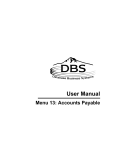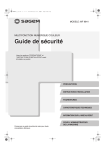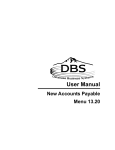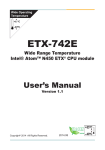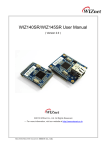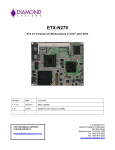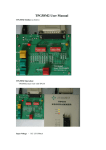Download SafeNet Authentication Client (Linux) User's Guide
Transcript
SafeNet Authentication Client (Linux) User’s Guide Version 8.0 Revision A Copyright © 2010, SafeNet, Inc. All rights reserved. All attempts have been made to make the information in this document complete and accurate. SafeNet, Inc. is not responsible for any direct or indirect damages or loss of business resulting from inaccuracies or omissions. The specifications contained in this document are subject to change without notice. SafeNet and SafeNet Authentication Client are trademarks of SafeNet, Inc. All other trademarks, brands, and product names used in this Manual are trademarks of their respective owners. SafeNet Hardware and/or Software products described in this document may be protected by one or more U.S. Patents, foreign patents, or pending applications. For details of FCC Compliance, CE Compliance and UL Notification, please contact SafeNet Support. iii Support We work closely with our reseller partners to offer the best worldwide technical support services. Your reseller is the first line of support when you have questions about products and services. However, if you require additional assistance you can contact us directly at: Telephone You can call our help‐desk 24 hours a day, seven days a week: USA: 1‐800‐545‐6608 International: +1‐410‐931‐7520 Email You can send a question to the technical support team at the following email address: [email protected] Website You can submit a question through the SafeNet Support portal: http://c3.safenet-inc.com/secure.asp Additional Documentation We recommend reading the following SafeNet Token publication: SafeNet Authentication Client (Linux) 8.0 Administrator’s Guide SafeNet Authentication Client (Linux) 8.0 User’s Guide SafeNet Authentication Client (Linux) 8.0 ReadMe iv Table of Contents 1. Introduction................................................................................................ 1 Overview.................................................................................................................... 2 New Features ............................................................................................................ 2 2. SafeNet Authentication Client User Interface....................................... 3 Overview of SafeNet Authentication Client User Interface ....................................... 4 SafeNet Authentication Client Tray Icon ................................................................... 6 Launching the Tray Menu ..................................................................................... 6 Tray Icon Menu ..................................................................................................... 6 Hiding and Unhiding the Tray Icon........................................................................ 7 SafeNet Authentication Client Tools Main Screen .................................................... 7 SafeNet Authentication Client Tools Main Screen Toolbar................................... 8 Simple View........................................................................................................... 9 Advanced View.................................................................................................... 12 3. Token Initialization ..................................................................................21 Overview of Token Initialization............................................................................... 22 Initializing a Token ................................................................................................... 22 Configuring Advanced Initialization Settings....................................................... 25 Changing the Token Initialization Key................................................................. 28 vi 4. Token Management.................................................................................31 Selecting the Active Token.......................................................................................32 Logging On to a Token.............................................................................................32 Importing a Certificate onto a Token........................................................................34 Exporting a Certificate from a Token .......................................................................37 Deleting a Certificate................................................................................................38 Changing the Token Password................................................................................39 Renaming a Token...................................................................................................41 Copying Token Information to the Clipboard ...........................................................41 Changing the Administrator Password....................................................................42 Unlocking a Token....................................................................................................44 Unlocking a Token Using Set Token Password ..................................................44 Unlocking a Token using Challenge Response ..................................................45 Deleting Token Content ...........................................................................................47 Viewing Token Information.......................................................................................48 Reader Settings .......................................................................................................49 5. SafeNet eToken Virtual ...........................................................................51 Overview of SafeNet eToken Virtual and SafeNet eToken Rescue ........................52 Using SafeNet eToken Virtual/SafeNet eToken Rescue to Replace a Lost Token.52 Connecting SafeNet eToken Virtual or SafeNet eToken Rescue............................53 Disconnecting SafeNet eToken Virtual or SafeNet eToken Rescue .......................53 Unlocking SafeNet eToken Virtual ...........................................................................54 Generating a One Time Password (OTP) ...............................................................55 6. Token Settings .........................................................................................57 Setting Password Quality.........................................................................................58 Setting Private Data Caching...................................................................................60 Setting RSA Key Secondary Authentication ...........................................................62 7. SafeNet Authentication Client Settings................................................65 Opening SafeNet Authentication Client Settings.....................................................66 Client Settings Password Quality ............................................................................66 Copying CA Certificates to a Local Store ................................................................67 Allowing password quality configuration on token after initialization.......................68 Allowing only an administrator to configure password quality on token..................69 Chapter 1 Introduction SafeNet Authentication Client enables token operations and the implementation of token based PKI solutions. In this chapter: Overview New Features 2 Overview Public Key Infrastructure (PKI) is a framework for creating a secure method for exchanging information based on public key cryptography, providing for trusted third‐party vetting of, and vouching for, user identities. It is an arrangement that consists of a system of digital certificates, Certificate Authorities, and other registration authorities that verify and authenticate the validity of each party involved in an internet transaction. SafeNet’s Authentication Client enables integration with various security applications. It enables token security applications and third party applications to communicate with the token. These include token PKI solutions usingPKCS#11 or proprietary token applications SafeNet Authentication Client enables the implementation of strong two‐factor authentication using standard certificates as well as encryption and digital signing of data. Generic integration with PKCS#11 security interfaces enables out‐of‐the‐box interoperability with a variety of security applications offering secure web access, PC and data security, secure email, and more. PKI keys and certificates can be created, stored, and used securely from within token hardware or software devices. SafeNet Authentication Client can be deployed and updated using any standard software distribution system. The SafeNet Authentication Client Tools application is installed by the SafeNet Authentication Client, providing easy‐to‐use configuration tools for users and administrators. New Features The following features were introduced in SafeNet Authentication Client 8.0 (for Linux): Support for eToken NG Flash 5.3/Support for eToken NG Flash 5.3 Anywhere (in PKI mode only). Support for upgrade from previous version. Chapter 2 SafeNet Authentication Client User Interface This section describes how to find your way around the SafeNet Authentication Client user interface. In this chapter: Overview of SafeNet Authentication Client User Interface SafeNet Authentication Client Tray Icon SafeNet Authentication Client Tools Main Screen 4 Overview of SafeNet Authentication Client User Interface Administrators use SafeNet Authentication Client Tools to set token policies. Users use Tools to perform basic token management functions, such as changing passwords and viewing certificates on the tokens. In addition, Tools provides users and administrators with a quick and easy way to transfer digital certificates and keys between a computer and a token. Tools includes an initialization feature allowing administrators to initialize tokens according to specific organizational requirements or security modes, and a password quality feature which sets parameters to calculate a token password quality rating. CAUTION: Do not remove the token from the USB port during an operation. This may cause corruption of data on the token. Tools provides information about the token, including its identification and capabilities. It has access to information stored on the token such as keys and certificates, and enables management of content, such as password profiles. To launch the application, do one of the following: Right‐click the application tray icon and select Tools from the menu. Double‐click the application tray icon From Linux desktop select Applications > SafeNet > SafeNet Authentication Client > SafeNet Authentication Client Tools. The SafeNet Authentication Client Tools window opens. Overview of SafeNet Authentication Client User Interface 5 6 SafeNet Authentication Client Tray Icon The SafeNet Authentication Client tray icon gives you quick access to many of the functions in the application. Launching the Tray Menu To access the tray menu: Click the application tray icon . The tray menu opens. Tray Icon Menu The following functions can be accessed quickly from the tray icon menu: Tools: launches SafeNet Authentication Client Tools. Generate OTP: generates OTP for SafeNet eToken Virtual. This function is available only if SafeNet eToken Virtual is configured to support this function. Delete Token Content: removes the deletable data from the token. Change Token Password: changes the token password. Tokens: provides the option to select the active token when more than one is inserted. About: displays product information Hide: hides the icon SafeNet Authentication Client Tools Main Screen 7 Hiding and Unhiding the Tray Icon To hide the tray Icon: Click the application tray icon and select Hide. To unhide the tray menu: Do one of the following: Remove and re‐insert the token Re‐boot the computer SafeNet Authentication Client Tools Main Screen Tools includes two viewing options: Simple View: to perform basic and common tasks. See Simple View on page 9. Advanced View: for complete control over the SafeNet Authentication Client and the inserted tokens. See Advanced View on page 12. Each view displays two panes: The left pane indicates which token (Simple View) or which object (Advanced View) is to be managed. The right pane enables the user to perform specific actions to the selected token or object. A toolbar at the top of the window enables certain actions to be initiated in both views. 8 SafeNet Authentication Client Tools Main Screen Toolbar The main screen toolbar is displayed in both Simple and Advanced View. The toolbar contains the following icons: Icon Action Advanced View – switches from the simple to the advanced view Simple View - switches from the advanced to the simple view Refresh – refreshes the data for all connected tokens About – displays product version information Help – launches the help SafeNet Home - opens the SafeNet’s website SafeNet Authentication Client Tools Main Screen Simple View The SafeNet Authentication Client Tools is launched in Simple View. When a token is inserted or SafeNet eToken Virtual is present, a specific icon representing the inserted token is displayed in the left pane. Each token has a name displayed to the right of the icon. My Token is the default name if no name has been assigned to the token. The selected token is marked by a shaded rectangle in the left pane. 9 10 Authenticator Icons The icon indicates the type of authenticator attached. Icon Type eToken PRO, SafeNet eToken Virtual, eToken NG Flash, eToken NG Flash Anywhere eToken PRO Anywhere SafeNet eToken Rescue eToken NG-OTP Reader eToken PRO Smartcard Broken token Unknown token SafeNet Authentication Client Tools Main Screen 11 Simple View Functions In the right pane, you can select any of the enabled buttons to perform the action described. Function Rename Token - sets the token name. Change Token Password – changes the token password. Unlock Token – resets the token password via a challenge response mechanism. Enabled only when an administrator password has been initialized on the token. Delete Token Content removes deletable data from the token. View Token Information – provides detailed information about the token. Disconnect SafeNet eToken Virtual – disconnects the SafeNet eToken Virtual or SafeNet eToken Rescue, with an option for deleting it. Button 12 Advanced View The Advanced View provides additional token management functions. To see the advanced view, click the Advanced View icon Simple View. in the The left pane provides a tree view of the different objects to be managed. The tree expands to show objects of inserted tokens. When you select an object, the relevant functions are available by clicking on the icons in the right pane, or by right clicking on the object and selecting the required function from the menu. SafeNet Authentication Client Tools Main Screen 13 Advanced View Functions You can access the advanced functions by selecting the required object from the left pane in the Tools Advanced View window. Tokens Node When you select the Tokens node, the list of attached tokens is displayed in the right pane. The following functions are available. 14 Function Icon Right-Click Menu Item Reader Settings See Reader Settings on page 49 Reader Settings Connect SafeNet eToken Virtual See Overview of SafeNet eToken Virtual and SafeNet eToken Rescue on page 52 Connect SafeNet eToken Virtual Attached Tokens The names of the tokens are displayed in the left pane. When you select a token, information about the token is displayed in the right pane and the name of the token reader is displayed in the tool‐tip. SafeNet Authentication Client Tools Main Screen The following user functions are available. User Function Icon Right-Click Menu Item Initialize Token See Token Initialization on page 21 Initialize User Logon to Token See Logging On to a Token as a User on page 33 Log on Import Certificate See Importing a Certificate onto a Token on page 34 Import Certificate Change Password See Changing the Token Password on on page 39. Change Password Rename Token See Renaming a Token on on page 41. Rename Disconnect SafeNet eToken Virtual. See Disconnecting SafeNet eToken Virtual or SafeNet eToken Rescue on on page 53 Disconnect Copy to Clipboard See Copying Token Information to the Clipboard on page 41 Not available 15 16 Some functions are available only if an administrator password has been set for the token. The administrator icons are located on the right of the window, enclosed within a border: Administrator Function Icon Right-Click Menu Item Log On as Administrator See Logging On to a Token as an Administrator on page 34. Log On as Administrator Change Administrator Password See Changing the Administrator Password on page 42. Change Administrator Password Unlock Token See Unlocking a Token using Challenge Response on page 45. Unlock Set Token Password (is activated only when you have logged on to the token with an administrator password) See Unlocking a Token Using Set Token Password on page 44. Set Token Password SafeNet Authentication Client Tools Main Screen 17 User Certificates If the token contains certificates, a User Certificates node is displayed in the left pane under the token. Information about the certificates on the token is displayed in the right pane. The following functions are available: 18 User Function Icon Right-Click Menu Item Import Certificate See Importing a Certificate onto a Token on page 34 Import Certificate Export Certificate See Exporting a Certificate from a Token on page 37 Export Certificate Delete Certificate See Deleting a Certificate on page 38 Delete Certificate Settings Each attached token has a Settings window. The settings window contains two tabs: SafeNet Authentication Client Tools Main Screen 19 Password Quality (See Setting Password Quality on page 58) Advanced (See Setting Private Data Caching on page 60 and Setting RSA Key Secondary Authentication on page 62) SafeNet Authentication Client Settings The client settings will affect all tokens that will be initialized after the settings have been configured. The SafeNet Authentication Client Settings window contains two tabs, as in the Settings window: Password Quality Advanced See SafeNet Authentication Client Settings on page 65. 20 Chapter 3 Token Initialization Token initialization restores a token to its initial state, removing all objects stored on the token since manufacture, frees up memory, and resets the token password. Typically, initialization is carried out on a token when an employee leaves the company, enabling the token to be issued to another employee. Note: You cannot initialize SafeNet eToken Virtual with SafeNet Authentication Client. In this chapter: Overview of Token Initialization Initializing a Token 22 Overview of Token Initialization The token initialization option restores a token to its initial state. It removes all objects stored on the token since manufacture, frees up memory, and resets the token password, allowing administrators to initialize the token according to specific organizational requirements or security modes. Initializing a token is useful, for example, after an employee has left a company. It completely removes the employee’s individual certificates and other personal data from the token, preparing it to be used by another employee. The following data is initialized: Token Name Token Password Administrator Password (optional) Login retries before token is locked (for token and administrator passwords) Token Password must be changed on first logon Initialization key Using customizable parameters, you can select specific parameters that will apply to certain tokens. These parameters may be necessary if you wish to use the token for specific applications or if you require a specific user or administrator password on all the tokens in the organization. Initializing a Token To initialize a token: 1. Click Initialize Token on the toolbar, or right‐click the token name in the left pane and select Initialize from the shortcut menu. The Initialize Token window opens. Initializing a Token 2. 3. 23 Enter a name for the token in the Token Name field. If no name is entered, the default name, “My Token”, is applied. Select Set Token Password to initialize the token with a token password. Otherwise, the token is initialized without a token password, and it will not be usable for SafeNet (eToken) applications. 24 4. If Set Token Password is selected, enter a new token password in the Set Token Password and Confirm fields. Note: The default password for a new token is 1234567890. If the user uses the default password during initialization, and default password quality requirements are used, the user must select the Token Password must be changed at first logon option. Otherwise the initialization will fail, as the default password will not meet default password quality requirements (See Setting Password Quality on page 58). If the Token Password must be changed at first logon field is selected, the initialization will succeed and the user will be prompted to set a new token password when next logging on with the token. The user will then be required to set a password meeting password quality requirements, as configured in the settings window (See Setting Password Quality on page 58). 5. To initialize an administrator password, select Set Administrator Password and enter a password in the Set Administrator Password and Confirm fields. (Minimum password length is 4 characters.) Note: Creating an administrator password enables certain functions to be performed on the token, such as resetting a token password on a locked token. 6. 7. 8. 9. In the Logon retries before token is locked field, enter a value between 1 and 15. This counter specifies the number of times the user or administrator can attempt to log on to the token with an incorrect password before the token is locked. The default number of incorrect logon attempts is 15. If required, select Token Password must be changed on first logon. This is selected by default. If you want to configure advanced settings, continue from the next section (see Configuring Advanced Initialization Settings). Click Start. When the initialization process is complete, a confirmation message is displayed. Initializing a Token Configuring Advanced Initialization Settings To configure advanced settings: 1. In the Initialize Token window click Advanced. The Advanced Token Initialization Settings window opens. 2. Complete the fields as follows: Field Description eToken PKI Client 3.65 compatible Select to maintain compatibility with token RTE 3.65. Password quality settings on token Select to keep password policy on the token device. (This is enabled only when the 3.65 compatible is selected). FIPS Select to enable FIPS support. FIPS (Federal Information Processing Standards) is a US government approved set of standards designed to improve the utilization and management of computer and related telecommunication systems. Any token with applet 1.1.25 or above supports FIPS. 25 26 Field (Continued) Description (Continued) One-factor logon Default: disabled. When one factor logon is enabled, only the presence of the token is required to log on to applications. A password is not required. Note: For security reasons, one-factor logon is not applied to SafeNet Authentication Client Tools. 2048-bit RSA key support Select to enable 2048-bit RSA key support (on compatible token). OTP support Select to enable OTP support (on compatible token). Private data caching In SafeNet Authentication Client, public information stored on the token is cached to enhance performance. This option defines when private information (excluding private keys on the physical token) can be cached outside the token. Select one of the following options: Always (fastest): always caches private information in the application memory. This enables fast performance, as certain information is cached on the host machine. However, this option is less secure than if no cache is allowed. While user is logged on: caches private data outside the token as long as the user is logged on to the token. Once the user logs out, all the private data in the cache is erased. Never: does not cache private data. Initializing a Token 27 Field (Continued) Description (Continued) RSA key secondary authentication An authentication password may be set for an RSA key. If this option is used, then in addition to having the token and knowing the token's password, accessing the RSA key requires knowing the password set for that particular key. This option defines the policy for using this secondary authentication of RSA keys. Always: every time an RSA key is generated, you are prompted to enter a secondary password for accessing this key. Clicking OK generates the key and uses the entered password as the secondary RSA password for that key. Clicking Cancel causes key generation to fail. Always prompt user: every time an RSA key is generated, a secondary password for accessing this key is requested. However, the user can choose to dismiss the prompt (by clicking Cancel), and key generation will continue without using a secondary password for the generated RSA key. Prompt on application request: this enables applications that use secondary authentication for RSA keys to make use of this feature on the token (when creating the key in Crypto API with a user protected flag). Never: secondary passwords are not created for any RSA key and the authentication method uses only the token password to access the key. Manually set the number of reserved RSA keys Set the number of reserved RSA keys. This ensures that there will always be memory available for this number of keys. Change Initialization Key The initialization key protects against accidental initialization and requires a separate password to be entered before initialization can occur. 3. 4. If you want to change the token initialization key continue from the next section (see Changing the Token Initialization Key on page 28), else, click OK to return to the Initialize Token window. Click Start. When the initialization process is complete, a confirmation message is displayed. 28 Changing the Token Initialization Key Two initialization keys can be provided during the initialization process. One is the current initialization key, it is required so the initialization can be done. The Default Initialization and Specified Initialization Key refer to current initialization key. Second is the Change Initialization key which is the new value of the initialization key that can be set during initialization. To change the Token Initialization Key: 1. In the Advanced Token Initialization Settings window, click Change Initialization Key. The Token Initialization Key window opens. Initializing a Token 2. 29 Complete the fields as follows: Field Description Use default initialization Key Select to use factory-set default. Use this initialization Key Enter the initialization key to be used. Change the key for the next initialization to: Set the new value of the 2nd initialization key for any of the 3 options specified. Default: Revert to default. Random: If selected, it will never be possible to re-initialize the token. This Value: Enter and confirm a a value for initialization key. 3. 4. Click OK to return to the Advanced Token Initialization Settings window, then click OK again to return to the Initialize Token window. Click Start. When the initialization process is complete, a confirmation message is displayed. 30 Chapter 4 Token Management The SafeNet Authentication Client Tools application and the SafeNet Authentication Client tray menu enable you to configure the options that control the use of token devices. In this chapter: Selecting the Active Token Logging On to a Token Importing a Certificate onto a Token Exporting a Certificate from a Token Deleting a Certificate Changing the Token Password Renaming a Token Copying Token Information to the Clipboard Changing the Administrator Password Unlocking a Token Deleting Token Content Viewing Token Information Reader Settings 32 Selecting the Active Token If more than one token is attached, you must select which device you want to work with. Note: The token selected here is relevant only for tray menu functions. To select the active token: 1. 2. Click the application tray icon . Select Tokens. A list of inserted tokens is displayed. 3. Select the required token. Logging On to a Token You can log on to a token as a user or as an administrator. An administrator has limited permissions on a token. No changes to any user information may be made, nor may the user’s security be affected. The administrator’s functions are restricted to Change Administrator Password, Set Token Password, Unlocking Token using Challenge Response and Change Password Quality Settings that are stored on the token. Logging On to a Token 33 Logging On to a Token as a User To log on as a user: 1. Open SafeNet Authentication Client Tools. 2. Click the Advanced View icon 3. . The Advanced View window opens. Do one of the following: Select the required token in the left pane and click the Log On to Token icon: Right‐click the required token in the left pane and select Log On from the shortcut menu. The Log on window opens. 4. Enter the token password in the Password field and click OK. The user is logged on. 34 Logging On to a Token as an Administrator To log on as an administrator: 1. 2. 3. Open SafeNet Authentication Client Tools. Click the Advanced View icon. Do one of the following: Select the required token in the left pane and click the Log on as Administrator icon: 4. Right‐click the required token in the left pane and select Log on as Administrator from the shortcut menu. The Log on dialog box opens. Enter the administrator password in the Password field and click OK. The user is logged on as the Administrator. Importing a Certificate onto a Token The following certificate types are supported: .pfx .p12 .cer Note: In Linux it is possible to export only to *.cer format. If a PFX file is selected, the private key and corresponding certificate will be imported to the token. You will be asked if CA certificates should be imported to the token, and you will be asked to enter the password (if it exists) protecting the PFX file. Importing a Certificate onto a Token 35 In the case of a CER file (which contains only X.509 certificates), the program checks if a private key exists on the token. If the private key is found, the certificate is stored with it. If no private key is found, then you are asked if you want to store the certificate as a CA certificate. Note: It is not possible to import a certificate onto SafeNet eToken Rescue. To import a certificate: 1. 2. 3. 4. Open SafeNet Authentication Client Tools. Click the Advanced View icon. In the left pane of the Advanced View window, select the required token. Do one of the following: In the left pane of the Advanced View window, select the required token and click the Import Certificate icon In the left pane of the Advanced View window, right click the required token and select Import Certificate from the menu. The Import Certificate window opens. 5. Select the following Import a certificate from a file Click OK. 6. 36 The Choose a certificate dialog box opens. 7. Select the certificate file to import and click Open. If the certificate requires a password, the Password dialog box opens. 8. Enter the certificate password. Exporting a Certificate from a Token 37 A window opens asking if you want to store the CA certificates on the token. 9. Select Yes or No. All requested certificates are imported, and a confirmation message opens. Exporting a Certificate from a Token A physical token or SafeNet eToken Virtual exports only the certificate without its key. Note: In Linux it is possible to export only to *.cer format. To export a certificate: 1. 2. 3. Open SafeNet Authentication Client Tools. Click the Advanced View icon. In the left pane of the Advanced View window, select the required certificate and click the Export Certificate icon. 38 The Save As window opens. 4. Select the location to store the certificate, enter a file name and click Save. Note: The certificate file must be DER encoded or Base64 (not PKCS #7). Deleting a Certificate You can remove a certificate from a token. To delete a certificate from a Token: 1. 2. 3. Open SafeNet Authentication Client Tools. Click the Advanced View icon. Do one of the following: In the left pane of the Advanced View window, expand the required token, select the required certificate and click the Delete Certificate icon. Changing the Token Password 39 In the left pane of the Advanced View window, expand the required token, right‐click the required certificate and select Delete Certificate from the shortcut menu. The Delete Certificate window opens. 4. Do one of the following: To cancel the deletion click No. To delete the certificate click Yes. Changing the Token Password All the manufactured token devices are configured with the factory initial password, 1234567890. To ensure strong, two factor security, it is important for the user to change the token password to a private token password as soon as the new token is received. When a token password has been changed, the new password is used for all token applications involving the token. It is the user’s responsibility to remember the token password. Without it, the user cannot use the token. Note: The token password is an important security measure in safeguarding your company’s private information. The best passwords are at least eight characters long and include upper and lower case letters, punctuation marks and numbers created in a random order. We recommend against using passwords that can be easily discovered, such as names or birth dates of family members. 40 To change the token password: 1. 2. 3. Open SafeNet Authentication Client Tools. In the left pane of the Tools window, select the token to which the new password will be assigned. Click Change Password in the right pane. Tip: You can change the token Password also by clicking on the application tray icon and selecting Change Token Password. The Change Password window is displayed. 4. 5. Enter the current token password in the Current Token Password field. Enter the new token password in the New Token Password and Confirm New Token Password fields. Note: As you type a new password, the password quality indicator on the right displays a percentage score of how well the new password matches the password quality policy. 6. Click OK. The token password is changed. Renaming a Token Renaming a Token You can change the token name. To rename a token: 1. 2. 3. 4. 5. 6. Open SafeNet Authentication Client Tools. In the left pane of the Tools window, select the token to be renamed. Click Rename Token in the right pane. If prompted, enter the token password. The Rename Token window opens. Enter the new name in the New Token name field. Click OK. The new token name is displayed in the Tools window. Copying Token Information to the Clipboard To copy and paste token information: 1. Do one of the following: In the Token Info window click Copy. 41 42 2. In Advanced view, select the required token in the left pane and click the Copy to Clipboard icon: Place the cursor in the target application and paste the information. Changing the Administrator Password Setting an administrator password on the token enables the administrator to unlock a locked token by resetting a new token password if it is forgotten. We recommend initializing all tokens with an administrator password. Password Quality feature enables the administrator to set certain complexity and usage requirements for the password. See Setting Password Quality on page 58. Note: Password is an important security measure in safeguarding your company’s private information. The best passwords are at least eight characters long and include upper and lower case letters, punctuation marks and numbers created in a random order. We recommend against using passwords that can be easily discovered, such as names or birth dates of family members. To change the Administrator Password: 1. 2. Open SafeNet Authentication Client Tools. To change the administrator password, do one of the following: Changing the Administrator Password 43 In the left pane of the Tools window, select the required token and click the Change Administrator Password icon: The Change Administrator Password icon is located at the right of the window, enclosed within a border: In the left pane of the Tools window, right‐click the required token and select Change Administrator Password from the menu. The Change Administrator Password window opens. 3. Enter the current administrator password in the Current Password field. Note: If an incorrect password is entered more than a specified number of times, the token will be locked. 4. 5. Enter the new administrator password in the New Password and Confirm Password fields. Click OK. The token’s administrator password is changed. 44 Unlocking a Token If you enter an incorrect password more than a specified number of times, the token hardware device, SafeNet eToken Virtual or SafeNet eToken Rescue will be locked. You can unlock the token only if an administrator password was set during initialization. The unlock feature is available for token hardware devices and SafeNet eToken Virtual. This feature is not available for SafeNet eToken Rescue. CAUTION: The number of times that SafeNet eToken Virtual can be unlocked can be limited to a specified number. If this number is exceeded, the SafeNet eToken Virtual becomes unusable and must be replaced. T If the administrator has access to the user’s computer, the token may be unlocked using the Set Token Password feature (see Unlocking a Token Using Set Token Password on page 44). When the administrator is located remotely, for example when an employee is out of the office, a Challenge Response authentication method can be employed to unlock the token (see Unlocking a Token using Challenge Response on page 45). With this method, the user sends the administrator the Challenge Code supplied by Tools, and then enters the Response Code provided by the administrator. The user then enters a new password and the token is unlocked. Unlocking a Token Using Set Token Password To unlock a token using Set Token Password: 1. 2. Log on to the token as an administrator (see Logging On to a Token as an Administrator on page 34). Do one of the following: Click the Set Token Password icon: Unlocking a Token 45 Right‐click the token in the left pane and select Set Token Password from the shortcut menu. The Set Password window opens. 3. 4. Enter a new password in the New Password and Confirm Password fields. The Logon retries before token is locked displays the maximum login failures set by the administrator during initialization. Click OK. The token is unlocked. You can now log on as a user with the new password. Unlocking a Token using Challenge Response To unlock a token using Challenge Response: 1. 2. 3. Open SafeNet Authentication Client Tools. In the left pane of the Tools window, select the token to be unlocked. Click Unlock Token in the right pane. The Unlock Token window is displayed. 46 4. Contact the administrator and provide the Challenge Code. Note: To copy the challenge code to the clipboard, click on the Copy challenge code to clipboard icon: CAUTION: After providing the Challenge Code to the administrator, do not undertake any activities that use the token until after receiving the Response Code and completing the unlocking procedure. If any other token activity occurs during this process, it will affect the context of the Challenge Response process and invalidate the procedure. Deleting Token Content 47 The administrator provides the Response Code to be entered. Note: The creation of response code depends on the backend application being used by the organization. System administrators should refer to the relevant documentation for details on how to generate the response code. 5. 6. 7. Select Token Password must change on first logon if the new password is known to others and must be changed. Enter a new token password in the Password and Confirm fields. Click OK. The token is unlocked and a confirmation message is displayed. Deleting Token Content The Delete Token Content function enables you to delete all deletable objects on your token. Objects types include data objects (profiles), keys and certificates (CA or user). Non‐deletable objects will not be removed. Non‐deletable objects are created when the administrator configures the object attributes. The Delete Token Content function leaves the data structure on your token intact. It is less wide‐reaching than the Initialize function which restores a token to its initial state, removing all objects stored on the token since manufacture and resets the token password (See Chapter 3 Token Initialization on page 21). 48 To Delete Token Content: 1. Click the application tray icon and select Delete Token Content from the menu. The Delete Token Content window opens, prompting you to confirm the delete action. 2. To continue with the delete process, click OK, else click Cancel. The Log On window opens. Enter the token password and click OK. The Delete Token Content window opens, confirming that the delete process has been successful. Click OK to finish. 3. 4. Viewing Token Information To view token information: 1. 2. 3. Open SafeNet Authentication Client Tools. In the left pane of the Tools window, select the required token. Click View Token Information in the right pane. Reader Settings 49 The Token Info window opens. Reader Settings During SafeNet Authentication Client installation, four virtual smart card and two SafeNet eToken Virtual readers are installed. The number of available hardware and software readers is configured by your system administrator. When a token is inserted into a USB port, or SafeNet eToken Virtual is added, the effect is the same as inserting a smart card into one of the readers. To display the number of readers: 1. 2. 3. Open SafeNet Authentication Client Tools. Click the Advanced View icon. Do one of the following: 50 Click the Reader Settings icon Right‐click the Tokens node and select Reader Settings from the shortcut menu The Reader Settings window opens. In Linux, the smart card service (pcscd) loads the smartcard driver dynamically. The number of virtual readers available for token is determined by the pcscSlots property value in the eToken.conf file. For more details, see SafeNet Authentication Client (Linux) Administrator’s Guide. 4. 5. 6. Set the required number of hardware or software readers in the appropriate field. The default number of available readers are: Hardware readers: 4 (On Linux platform this is disabled, and shows how many tokens can be connected, determined by the pcscslots property value.) Software readers: 2 Click OK to close the window. Restart Tools to make the changes effective. Chapter 5 SafeNet eToken Virtual SafeNet Authentication Client supports the SafeNet eToken Virtual line of products. This includes SafeNet eToken Virtual and SafeNet eToken Rescue. These are stored as files on your computer or on a mass storage device. Tip: To obtain SafeNet eToken Rescue or SafeNet eToken Virtual, contact your system administrator. In this chapter: Overview of SafeNet eToken Virtual and SafeNet eToken Rescue Using SafeNet eToken Virtual/SafeNet eToken Rescue to Replace a Lost Token Connecting SafeNet eToken Virtual or SafeNet eToken Rescue Disconnecting SafeNet eToken Virtual or SafeNet eToken Rescue Unlocking SafeNet eToken Virtual Generating a One Time Password (OTP) 52 Overview of SafeNet eToken Virtual and SafeNet eToken Rescue SafeNet Authentication Client supports software tokens. The following types of software tokens are available: SafeNet eToken Rescue: provides a solution when a staff member loses or damages a token when away from the office. SafeNet eToken Rescue is a read‐only token. You cannot import certificates. It operates for a limited period of time. SafeNet eToken Virtual: performs all the functions of an eToken NG‐OTP. It supports OTP generation (if so configured). SafeNet eToken Virtual is “locked” to a particular computer or storage device (such as a flash drive). This means that it can be used only on the computer or storage device where it was enrolled. SafeNet eToken Virtual Temp: identical to SafeNet eToken Virtual, but contains certificates which become invalid after a specified time period. Using SafeNet eToken Virtual/SafeNet eToken Rescue to Replace a Lost Token To use SafeNet eToken Virtual/SafeNet eToken Rescue to replace a lost token, the SafeNet eToken Virtual/SafeNet eToken Rescue must be enrolled using the Token TMS Client. For more details, refer to the Token TMS Client documentation. Connecting SafeNet eToken Virtual or SafeNet eToken Rescue 53 Connecting SafeNet eToken Virtual or SafeNet eToken Rescue To connect SafeNet eToken Virtual or SafeNet eToken Rescue: 1. 2. 3. Open SafeNet Authentication Client Tools. Click the Advanced View icon. Select Tokens in the left pane. 4. Click the Connect SafeNet eToken Virtual icon or right‐ click Tokens and select Connect SafeNet eToken Virtual from the shortcut menu. Navigate to the SafeNet eToken Virtual file (*.etvp) or SafeNet eToken Rescue file (*.etv) and click it. The SafeNet eToken Virtual/SafeNet eToken Rescue file is added. Click OK. 5. 6. Disconnecting SafeNet eToken Virtual or SafeNet eToken Rescue When the SafeNet eToken Virtual is no longer necessary, disconnect it from its attached reader. To disconnect SafeNet eToken Virtual or SafeNet eToken Rescue: 1. 2. 3. 4. Open SafeNet Authentication Client Tools. Click the Advanced View icon. Select the SafeNet eToken Virtual or SafeNet eToken Rescue to be disconnected and do one of the following: In the left pane, right‐click and select Disconnect. In the right pane, click Disconnect SafeNet eToken Virtual (or Disconnect SafeNet eToken Rescue) icon. The Disconnect SafeNet eToken Virtual message is displayed. Do one of the following: 54 To keep the SafeNet eToken Virtual/SafeNet eToken Rescue file on the computer, click Disconnect; only the connection from the SafeNet eToken Virtual to the SafeNet Authentication Client is disconnected. To remove the SafeNet eToken Virtual/SafeNet eToken Rescue file from the computer, click Delete. Note: Disconnecting the SafeNet eToken Virtual/SafeNet eToken Rescue is applicable when the user is out of the office and may need to use the SafeNet eToken Virtual/SafeNet eToken Rescue on the road later. When the lost token is replaced, the SafeNet eToken Virtual/SafeNet eToken Rescue should be deleted from the computer. After the SafeNet eToken Virtual/SafeNet eToken Rescue is deleted, it can be recreated only by reinstalling it. Unlocking SafeNet eToken Virtual Note: The unlock function is supported only by SafeNet eToken Virtual (not SafeNet eToken Rescue). If you enter an incorrect password more than a specified number of times, the SafeNet eToken Virtual will be locked. See Unlocking a Token using Challenge Response on page 45 or Unlocking a Token Using Set Token Password on page 44. Note: The number of times that SafeNet eToken Virtual can be unlocked can be limited to a specified number. If this number is exceeded, the SafeNet eToken Virtual becomes unusable. Generating a One Time Password (OTP) 55 Generating a One Time Password (OTP) The Generate OTP function is available only if SafeNet eToken Virtual or SafeNet eToken Rescue, with the OTP feature activated, is stored on your computer. To generate an OTP: 1. 2. 3. 4. Click the application tray icon . The SafeNet Authentication Client tray menu opens. Select Generate OTP. The Generate OTP window opens. Click Generate OTP. The Log on window opens. Enter the token password. The generated OTP is displayed in the Generate OTP window. 56 Chapter 6 Token Settings Configurations set in token settings determine behavior that applies to the specific token. In this chapter: Setting Password Quality Setting Private Data Caching Setting RSA Key Secondary Authentication 58 Setting Password Quality Once password quality parameters are set, any future passwords are automatically checked against these parameters to determine the password’s level of acceptability. If the token was initialized in early PKI Client versions (RTE), no password policy is stored on the token. To set password quality: 1. 2. 3. 4. Open SafeNet Authentication Client Tools. Click the Advanced View icon. In the left pane of the Advanced View window, expand the required token and select Settings. In the right pane select the Password Quality tab. Setting Password Quality 5. Enter the password quality parameters as follows: Password Quality Parameter Description Minimum password length (characters) Default: 6 characters Maximum password usage period (days) The maximum period before which the password must be changed. Default: 0 (none) Minimum password usage period (days) The minimum period before the password can be changed Default: 0 (none) Password expiration warning period (days) Defines the number of days before the password expires that a warning message is shown. Default: 0 (none) Password history size Defines how many previous passwords should not be repeated. Default: 10 Maximum character repetitions in a password Defines number of times a character can be repeated in the password. Default: 3 The password must comply with the complexity rules Determines if the complexity requirements are required in the token password. At least 3 rules: Complexity requirements are enforced None: Complexity requirements are not enforced Manual: Complexity requirements, as set manually in the Manual Complexity settings, are enforced (Default) 59 60 Password Quality Parameter (Continued) Description (Continued) Manual Complexity Rules For each of the character types (Numerals, Upper-case letters, Lower-case letters and Special Characters) select one of the following options: Permitted - Can be included in the password, but is not mandatory (Default). Mandatory - Must be included in the password. Forbidden - Must not be included in the password. 6. Do one of the following: To save your changes click Save. To ignore your changes click Discard. To return to default settings click Set to Default. Setting Private Data Caching In SafeNet Authentication Client, public information stored on the token is cached to enhance performance. This option defines when private information (excluding private keys on the physical token) can be cached outside the token. To set private data caching: 1. 2. 3. 4. Open SafeNet Authentication Client Tools. Click the Advanced View icon. In the left pane of the Advanced View window, expand the required token and select Settings. In the right pane select the Advanced tab. Setting Private Data Caching 5. 6. 61 In the Private data caching field select one of the following options: Option Description Always (fastest) Always caches private information in the application memory. This enables fast performance, as certain information is cached on the host machine. However, this option is less secure than if no cache is allowed. While user is logged on Caches private data outside the token as long as the user is logged on to the token. Once the user logs out, all the private data in the cache is erased. Never Does not cache private data. Do one of the following: To save your changes click Save. To ignore your changes click Discard. 62 Setting RSA Key Secondary Authentication An authentication password may be set for an RSA key. If this option is used, then in addition to having the token and knowing the tokenʹs password, accessing the RSA key requires knowing the password set for that particular key. This option defines the policy for using this secondary authentication of RSA keys. To set RSA key secondary authentication: 1. 2. 3. 4. Open SafeNet Authentication Client Tools. Click the Advanced View icon. In the left pane of the Advanced View window, expand the required token and select Settings. In the right pane select the Advanced tab. Setting RSA Key Secondary Authentication 5. 6. 63 In the RSA key secondary authentication field, select one of the following options: Option Description Always Every time an RSA key is generated, you are prompted to enter a secondary password for accessing this key. Clicking OK generates the key and uses the entered password as the secondary RSA password for that key. Clicking Cancel causes key generation to fail. Always prompt user Every time an RSA key is generated, a secondary password for accessing this key is requested. However, the user can choose to dismiss the prompt (by clicking Cancel), and key generation will continue without using a secondary password for the generated RSA key. Prompt on application request This enables applications that use secondary authentication for RSA keys to make use of this feature on the token (when creating the key in Crypto API with a user protected flag). Never Secondary passwords are not created for any RSA key and the authentication method uses only the token password to access the key. Do one of the following: To save your changes click Save. To ignore your changes click Discard. 64 Chapter 7 SafeNet Authentication Client Settings The SafeNet Authentication Client Settings set the parameters that apply to all tokens that are initialized after the settings have been configured. In this chapter: Opening SafeNet Authentication Client Settings Client Settings Password Quality Copying CA Certificates to a Local Store Allowing password quality configuration on token after initialization Allowing only an administrator to configure password quality on token 66 Opening SafeNet Authentication Client Settings To open SafeNet Authentication Client Settings: 1. 2. 3. Open SafeNet Authentication Client Tools. Click the Advanced View icon. In the left pane of the Advanced View window, select Client Settings. Client Settings Password Quality To set the Client Settings Password Quality: 1. 2. Open SafeNet Authentication Client Tools. Select Client Settings in Advance View (See Opening SafeNet Authentication Client Settings on page 66). Copying CA Certificates to a Local Store 3. 4. 67 Select the Password Quality tab. Change the password quality settings. Tip: The SafeNet Authentication Client Settings password quality is configured in the same way as the token password quality settings. See Setting Password Quality on page 58) 5. Do one of the following: To save your changes click Save. To ignore your changes click Discard. To return to default settings click Set to Default. Copying CA Certificates to a Local Store CA certificates can be downloaded onto a token. When the token is inserted into the computer, one or more of these CA certificates may not be on the computer. In such a case, the CA certificate may be loaded onto the computer. This option is selected by default. To open CA certificate management: 1. 2. Open SafeNet Authentication Client Tools. Select Client Settings in Advance View (See Opening SafeNet Authentication Client Settings on page 66). 68 3. Select the Advanced tab. 4. 5. Select Copy CA certificates to a local store. Do one of the following: To save your changes click Save. To ignore your changes click Discard. Allowing password quality configuration on token after initialization The Allow password quality configuration on token after initialization option defines whether the password quality parameters may be changed after initialization. This option is selected by default. Allowing only an administrator to configure password quality on token 69 To allow password quality configuration on token after initialization: 1. 2. 3. 4. 5. Open SafeNet Authentication Client Tools. Select Client Settings in Advance View (See Opening SafeNet Authentication Client Settings on page 66). Select the Advanced tab. Select Allow password quality configuration on token after initialization. Do one of the following: To save your changes click Save. To ignore your changes click Discard. Allowing only an administrator to configure password quality on token The Allow only an administrator to configure password quality on token option defines whether the password quality parameters may be changed after initialization by the administrator, or, if unchecked, by the user. This option is selected by default. To allow only an administrator to configure password quality on token: 1. 2. 3. 4. 5. Open SafeNet Authentication Client Tools. Select Client Settings in Advance View (See Opening SafeNet Authentication Client Settings on page 66). Select the Advanced tab. Do one of the following: To enable configuration by administrator, check Allow only an administrator to configure password quality on token. To enable configuration by user, uncheck Allow only an administrator to configure password quality on token. Do one of the following: To save your changes click Save. To ignore your changes click Discard. 70













































































